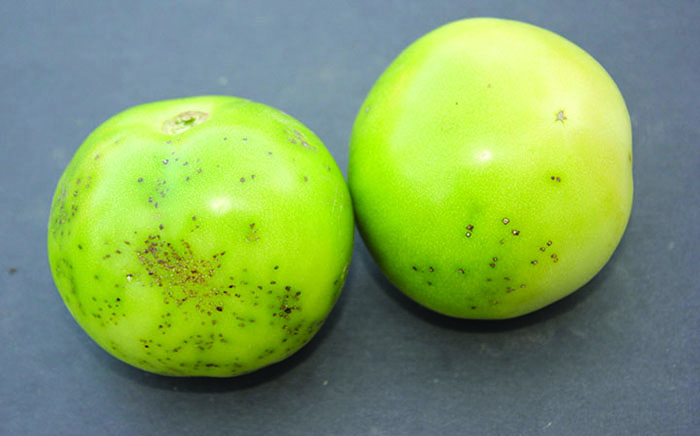
Bacterial speck
Pseudomonas syringae
Bacterial speck is a disease caused by
Symptoms:
- The infection of bacterial speck causes small, raised, brown specks on the fruit. Small dark spots may appear on the leaves of the tomato plant, usually on the underside. Spots may enlarge and develop a yellow halo. Eventually the leaves may yellow and fall off.
Prevention:
- Use hot-water treated seeds. If you have saved seeds from tomatoes previously affected by bacterial speck, soak seeds in 50°C (122°F) hot water for 25 minutes.
- Sow seeds in sterile soil-less mix, not garden soil.
- Avoid handling tomato plants when the garden is wet as this can spread the bacteria.
- Water early in the day if using a sprinkler so that plants dry quickly.
- Disinfect tools used around affected tomato plants with Lysol. Use a disenfectant like Lysol (at label directions for concentration) or an alcohol-based disinfectant in a spray bottle. Spritz it on your pruning tools and wipe with a soft cloth. Do not use bleach as it will corrode your tools.
- Use a mulch under tomato plants (even ones in pots) to avoid soil-splash which can spread the disease.
- Rotate where you grow tomatoes every year. Do not plant in the same location for at least three years.
- Remove and destroy debris at the end of the season. Debris can be hot-composted.
- Plant resistant varieties: 'Window box roma', 'Muriel'.
Can I eat the fruit?
Bacterial speck itself is not a human pathogen, but the blemishes caused by the bacteria can be entry points for human pathogens that could cause illness. Do not eat the affected fruit.
Source:
Howard, R. J., Seaman, W. L., & Garland, J. A. (Eds.). (2002). Diseases and pests of vegetable crops in Canada. Vancouver, British Columbia: The Canadian Phytopathological Society and the Entomological Society of Canada.

